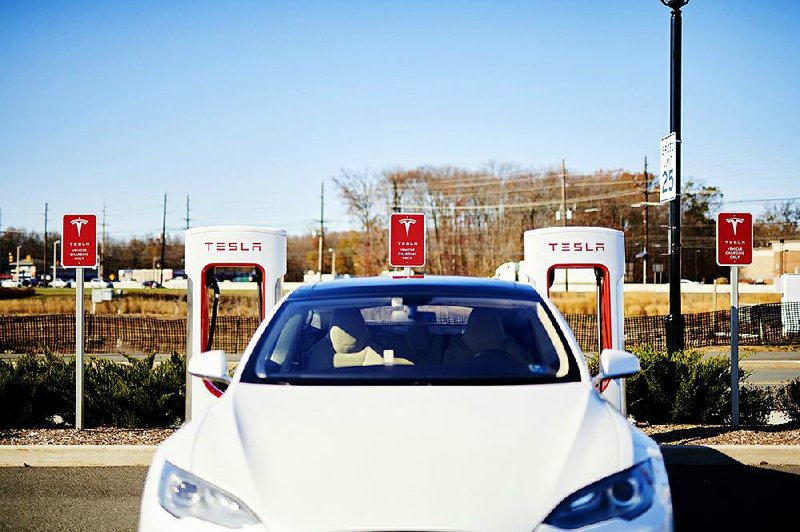SEATTLE -- When Seattle City Light unveiled five new electric-vehicle charging stations last month in an industrial neighborhood south of downtown, the electric utility wasn't just offering a new spot for drivers to power up. It also was creating a way for the utility to figure out how much more power it might need as electric vehicles catch on.
Seattle aims to have nearly a third of its residents driving electric vehicles by 2030. Washington state is No. 3 in the nation in per-capita adoption of plug-in cars, behind California and Hawaii. But as Washington and other states urge their residents to buy electric vehicles -- a crucial component of efforts to reduce carbon emissions -- they also need to make sure the electric grid can handle it.
The average electric vehicle requires 30 kilowatt-hours to travel 100 miles -- the same amount of electricity an average American home uses each day to run appliances, computers, lights and heating and air conditioning.
A U.S. Department of Energy study found that increased electrification across all sectors of the economy could boost national consumption by as much as 38% by 2050, in large part because of electric vehicles. The environmental benefit of electric cars depends on the electricity being generated by renewables.
So far, states predict they will be able to sufficiently boost power production. But whether electric vehicles will become an asset or a liability to the grid largely depends on when drivers charge their cars.
Electricity demand fluctuates throughout the day; demand is higher during daytime hours, peaking in the early evening. If many people buy electric vehicles and mostly try to charge right when they get home from work -- as many currently do -- the system could get overloaded or force utilities to deliver more electricity than they're currently capable of producing.
In California, for example, the worry is not so much with the state's overall power capacity, but rather with the ability to quickly ramp up production when demand is high, said Sandy Louey, media relations manager for the California Energy Commission, in an email. About 150,000 electric vehicles were sold in California in 2018 -- 8% of all state car sales.
The state predicts that electric vehicles will consume 5.4% of the state's electricity, or 17,000 gigawatt-hours, by 2030.
Responding to the growth in electric vehicles will present unique challenges for each state.
A November report sponsored by the U.S. Department of Energy found that there has been almost no increase in electricity demand nationwide over the past 10 years, while capacity has grown an average of 12 gigawatts per year (1 gigawatt can power more than half a million homes). That means energy production could climb at a similar rate and still meet even the most aggressive increase in electric vehicles, with proper planning.
CHARGING TIMES MATTER
Charging during off-peak hours not only would allow many electric vehicles to be added to the roads, but also allow utilities to get more use out of power plants that currently run only during the limited peak times.
Seattle City Light and other utilities are looking at various ways to promote charging during ideal times. One method is time-of-day rates. For the Seattle chargers unveiled last month, users will pay 31 cents per kilowatt-hour during peak daytime hours and 17 cents during off-peak hours. The utility will monitor use at its charging stations to see how effective the rates are at shifting charging to more favorable times.
"Even if there's an overall increase in consumption, it really matters when that occurs," said Sally Talberg, head of the Michigan Public Service Commission, which oversees the state's utilities. "The encouragement of off-peak charging and other technology solutions that could come to bear could offset any negative impact."
One of those solutions is smart charging, a system in which vehicles are plugged in but don't charge until they receive a signal from the grid that demand has tapered off a sufficient amount. This is often paired with a lower rate for drivers who use it. Several smart charging pilot programs are being conducted by utilities, though it has not yet been phased in widely.
Utility officials say the technology will be ready by the time widespread purchases of electric vehicles make it necessary.
WELCOMING GROWTH
In many places, the increased electricity demand from electric vehicles is seen as a benefit to utilities and ratepayers. In the Northwest, electricity consumption has remained relatively stagnant since 2000, despite robust population growth and development. That's because increasing urbanization and building efficiency have driven down electricity needs.
Electric vehicles could help push electricity consumption closer to utilities' capacity for production. That would bring in revenue for the providers, which would help defray the costs for maintaining that capacity, lowering rates for all customers.
Colorado also is working to promote electric cars, with the aim of putting 940,000 on the road by 2030. The state has adopted California's zero-emission vehicles mandate, which requires automakers to reach certain market goals for their sales of cars that don't burn fossil fuels, while extending tax credits for the purchase of such cars, investing in charging stations and electrifying state fleets.
Auto dealers have opposed the mandate, saying it infringes on consumer freedom.
"We think it should be a customer choice, a consumer choice and not a government mandate," said Tim Jackson, president and chief executive officer of the Colorado Automobile Dealers Association.
Jackson also said that there's not yet a strong consumer appetite for electric vehicles, meaning that manufacturers that fail to sell the mandated number of emission-free vehicles would be required to purchase credits, which he thinks would drive up the price of their other models.
Business on 01/11/2020

